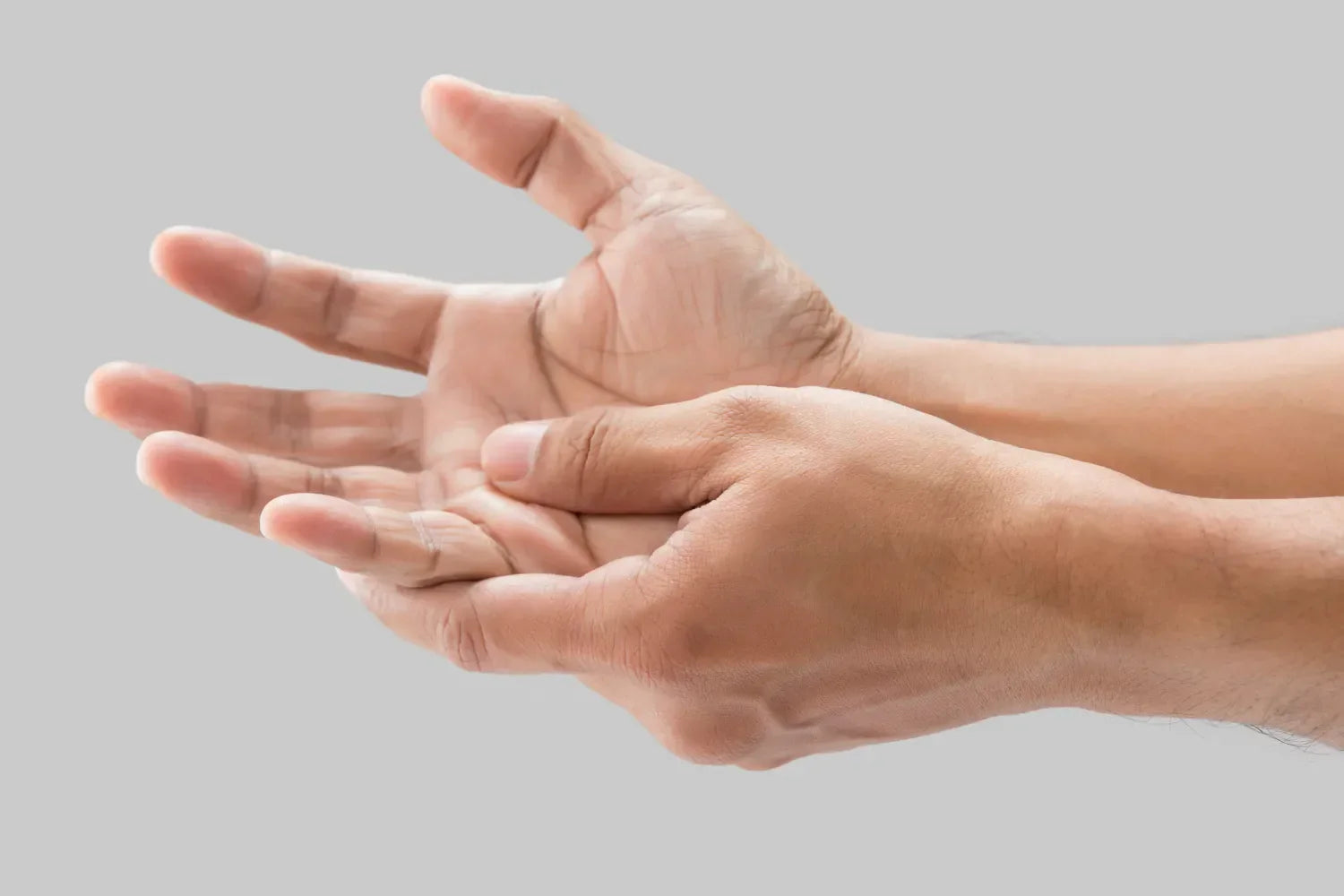
Experiencing ulnar wrist pain can be a significant hurdle in daily life. This particular type of discomfort, often described as 'pain on the outside of the wrist,' can interfere with simple tasks such as writing, lifting objects, or even shaking hands.
Over time, persistent ulnar wrist pain can impact your overall quality of life, making it essential to understand and manage this condition effectively. We’re going to dive into what ulnar wrist pain is, its common causes, and various strategies for managing this discomfort.
Our goal is to help you navigate this condition and provide insights on how to stay active and feel your best every day.
What Is Ulnar Wrist Pain?
Ulnar wrist pain is a specific type of discomfort that manifests on the outside of the wrist, in the area of the ulna bone. This region, also known as the 'ulnar side' of the wrist, can be a source of persistent pain, impacting your ability to perform everyday tasks.
The wrist is a complex structure consisting of numerous bones, ligaments, tendons, and nerves. These intricate components work together to enable a wide range of movements, from simple actions like gripping objects to more complex tasks requiring rotation and flexibility. On the ulnar side, these structures are particularly important in providing strength and stability to the wrist.
However, the complexity of the wrist can also make it vulnerable to various forms of discomfort and injury. Ulnar wrist pain can be acute, occurring suddenly due to an injury, or chronic, developing gradually over time.
This pain may be accompanied by other symptoms such as swelling, weakness, or a decrease in wrist mobility, further complicating the condition. In the following sections, we will explore the common causes of ulnar wrist pain and provide guidance on how to manage this discomfort.
What Causes Ulnar Wrist Pain?
There are several common causes of ulnar wrist pain, each resulting from different factors. These causes can range from acute injuries to chronic conditions, and understanding them can help you manage your discomfort more effectively.
- Injuries: Acute injuries, such as a fall on an outstretched hand, can lead to fractures or sprains in the ulnar area of the wrist, leading to immediate pain. These injuries can result from accidents, sports, or even everyday activities that involve a sudden impact or force on the wrist.
- Overuse: Repetitive motions, such as those often performed in certain sports or occupations, can strain the structures in the ulnar wrist over time. This overuse can lead to conditions like tendinitis, causing chronic pain. Jobs or hobbies that involve repetitive wrist movements or prolonged periods of gripping can contribute to this.
- Degenerative Conditions: As we age, natural wear and tear can lead to degenerative conditions like osteoarthritis, which can cause chronic ulnar wrist pain. This degeneration can affect the cartilage in the wrist, leading to pain and stiffness.
- Medical Conditions: Certain medical conditions, such as rheumatoid arthritis or ganglion cysts, can also lead to discomfort in the ulnar side of the wrist. These conditions can cause inflammation, swelling, and pain, affecting the overall function of the wrist.
Understanding the cause of your ulnar wrist pain is a crucial step toward effectively managing it. However, due to the complexity of the wrist's structure and the wide range of potential causes, it's often necessary to seek professional guidance to accurately identify the root cause of the discomfort.
How Is Ulnar Wrist Pain Diagnosed?
Diagnosing ulnar wrist pain is a comprehensive process that often begins with a thorough physical examination by a healthcare professional. They may assess your wrist's range of motion, strength, and flexibility and look for any signs of swelling or tenderness.
Your doctor will likely ask about your symptoms, the activities that exacerbate the pain, and any history of wrist injuries or related conditions. In addition to a physical examination, your healthcare provider may order imaging tests such as X-rays, CT scans, or MRI.
These imaging tests provide a detailed view of the wrist's structures, allowing the healthcare professional to identify any abnormalities like fractures, ligament tears, or signs of degenerative conditions. These insights can be crucial in determining the root cause of your ulnar wrist pain and devising an effective treatment plan.
While understanding the potential causes of ulnar wrist pain is important, an accurate diagnosis should always be made by a healthcare professional. Self-diagnosis can lead to incorrect treatment and potentially exacerbate the problem. It's always best to consult with a healthcare professional who can provide a comprehensive evaluation and guide you toward the most effective treatment options for your specific condition.
How Can You Manage Ulnar Wrist Pain at Home?
If you're experiencing ulnar wrist pain, there are several strategies you can employ at home to manage the discomfort. These strategies are not only aimed at relieving discomfort but also at promoting overall wrist health.
Rest
One of the most straightforward and effective strategies is to give your wrist a break from activities that exacerbate the pain. This rest can help reduce inflammation and prevent further injury. If your work or hobbies involve repetitive wrist movements, consider taking frequent breaks to rest your wrist.
Ice
Applying a cold pack to the affected area for 15 to 20 minutes at a time can help reduce swelling and relieve pain. Be sure to wrap the ice pack in a thin towel to protect your skin. This strategy is particularly effective for acute injuries or flare-ups of chronic conditions.
Gentle Exercises
Certain stretching and strengthening exercises can help improve flexibility and strength in the wrist, supporting overall wrist health. These exercises should be done gently and stopped if they cause pain. Your healthcare provider or a physical therapist can provide guidance on appropriate exercises for your specific condition.
Supportive Gear
Wearing supportive gear, like wrist sleeves, can help provide comfort and support to the affected wrist. These products are designed to offer support and help maintain your wrist's mobility.
Pain Management
Over-the-counter pain relievers can be used to manage acute pain episodes. However, these should be used sparingly and under the guidance of a healthcare professional, as long-term use can lead to side effects.
Healthy Lifestyle
Maintaining a healthy lifestyle can also support your overall wrist health. This includes eating a balanced diet, staying hydrated, and getting regular exercise. These factors contribute to overall body health, which in turn supports the health of your joints, including your wrists.
These strategies can help manage mild to moderate ulnar wrist pain. However, if your pain is severe, persistent, or accompanied by other concerning symptoms, it's important to seek medical attention.
When Should You Seek Professional Help for Ulnar Wrist Pain?
While home management strategies can be effective for mild ulnar wrist pain, there are situations where professional help is necessary. If your pain persists despite home treatment, worsens over time, or is severe enough to interfere with your daily activities, it's time to consult a healthcare professional.
Other signs that you should seek medical attention include noticeable swelling, changes in skin color, or a decrease in your wrist's range of motion. Additionally, if your pain is accompanied by other symptoms, such as numbness or tingling in the hand or fingers, it's important to get a professional evaluation.
Always seek the advice of your healthcare provider with any questions you may have regarding a medical condition or treatment.
How Can Copper Fit Products Support Your Wrist Health?
Copper Fit offers a range of products designed to support your wrist health. Our wrist sleeves, for example, are designed to provide comfortable support and help maintain your wrist's mobility. They're made with copper-infused fabric, which helps reduce odors, a benefit that our customers appreciate.
Relief at Hand: Managing Ulnar Wrist Pain Effectively
Ulnar wrist pain can be a challenging condition to deal with, but understanding its causes and knowing how to manage it can go a long way towards improving your comfort. Whether it's making lifestyle adjustments, using supportive products, or seeking professional medical advice, taking proactive steps can help you manage your ulnar wrist pain effectively.
At Copper Fit, we're committed to supporting your comfort and recovery, empowering you to stay active and feel your best every day. If your ulnar wrist pain persists despite these measures, don't hesitate to seek professional medical help.
Sources:
Mayo Clinic Minute: Avoiding overuse wrist injuries
Ice Packs vs. Warm Compresses For Pain | Johns Hopkins Medicine





